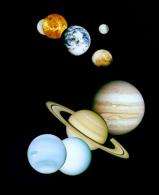STAR TRAK for December: Geminid meteors flash in December skies

(PhysOrg.com) -- The annual Geminid meteor shower, which will reach its maximum on the night of Dec. 13-14, usually offers the best show of the year, outperforming even the Perseid shower of August. This year the Geminids will peak three days after new moon, so viewing conditions should be favorable. In a clear sky, observers may see more than 100 meteors per hour.
Some meteors will appear as soon as the sky is completely dark, and the numbers will increase as the evening advances. The nights before and after the peak should also provide good viewing opportunities.
These "shooting stars" will seem to be coming from a point called the radiant near the bright stars Castor and Pollux in the constellation Gemini the Twins, which gives the shower its name. The radiant will be well above the eastern horizon a few hours after sundown and will remain high in the sky for the rest of the night. The higher the radiant is above the horizon, the more meteors there will be. Try facing southeast if you have a clear view in that direction, though meteors will be visible in all parts of the sky. For details about the Geminid shower, see www.amsmeteors.org/showers.html#geminids .
To stay comfortable in the frigid night, wear several layers of your warmest clothing and keep a thermos of hot coffee, tea or chocolate handy. A sleeping bag or blankets also will help. No special equipment is needed to watch a meteor shower -- a reclining lawn chair will work fine. Try facing in different directions and see how the meteors vary in appearance. The ones closer to the radiant will be short, because they will appear to be coming toward you. Those farther from the radiant will be longer.
If the Geminid meteors are overwhelmed by moonlight, you'll have another opportunity when the Ursid shower peaks before dawn on Dec. 22. The Ursid radiant is near the bright star Polaris, the north star, which is above the horizon and visible all night. The usual rate is about 10 meteors per hour, but sometimes there are bursts of 30 or more per hour. The Ursid shower will be active from Dec. 17 to Dec. 26, and moonlight won't be much of a problem after midnight.
Planets
Jupiter will be fairly high in the south-southwest as darkness falls at the beginning of December. Observers with telescopes should view it as early in the evening as possible, before it sinks too low. Jupiter will descend toward the sun's afterglow as the month advances, eventually setting as early as 8:30 p.m. EST.
Mercury will probably be too low to see without binoculars at the start of the month, but by Dec. 12 it should be fairly easy to spot above the southwestern horizon a half hour after sunset. It will be visible for about three weeks before it sinks rapidly into the solar glare near month's end.
Mars will rise before 10 p.m. local time at the beginning of December and two hours earlier by month's end, among the stars of the constellation Leo the Lion. The orange planet will double in brightness as the month progresses. The only brighter objects in the sky at that time of night will be Jupiter and the bright star Sirius.
Saturn will climb into the eastern sky about four hours after Mars, appearing high in the south shortly before dawn, the best position for viewing with a telescope. Saturn's famous rings are now easily visible again, after being tilted close to edgewise. Titan, its brightest moon, will be near Saturn the mornings of Dec. 1, 9, 17 and 25 and will show up in any telescope.
Venus will be barely visible near the eastern horizon at the start of December, and it will disappear into the bright glow of dawn well before month's end.
Solstice
The sun will be farthest south in Earth's sky on Dec. 21 at 12:47 p.m. EST (17:47 Universal Time), marking the beginning of winter in the Northern Hemisphere and summer in the Southern Hemisphere. For the next six months in the Northern Hemisphere the days will be getting longer.
"Blue moon"
December will offer something unusual -- a "blue moon." The moon will be full on Dec. 2 and then full again on Dec. 31. The second full moon in a month is traditionally called a blue moon. This last happened on April 30, 2007.
According to the Oxford English Dictionary, the first reference to a blue moon was in a proverb recorded in 1528, and it meant an obvious absurdity. Since then other meanings have emerged, ranging from the ecclesiastical calendar's name for the 13th moon in a year to the modern phrase "once in a blue moon," meaning very rarely. Blue moons are really not that uncommon, happening about once every three years.
The moon actually has appeared blue at times, because of smoke or dust particles in the atmosphere from huge forest fires, for example. More information is available at www.inconstantmoon.com/cyc_blue.htm .
Moon phases
The moon will be full on Dec. 2, at third quarter on Dec. 8, new on Dec. 16, at first quarter on Dec. 24 and full again (a "blue moon") on Dec. 31.
Provided by Indiana University (news : web)





















